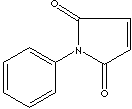| CAS
NO. |
941-69-5 |

|
| EINECS
NO. |
213-382-0 |
| FORMULA |
C10H7NO2 |
| MOL
WT. |
173.17 |
|
H.S.
CODE
|
2925.19
|
|
TOXICITY
|
Oral
rat LD50: 58 mg/kg |
| SYNONYMS |
Maleimidobenzene;
Maleanil; 1-Phenyl-1H-pyrrole-2,5-dione;
|
| N-Phenylmaleic
Acid Imide; N-Fenylimid kyseliny maleinove;
PMI; |
|
SMILES |
|
|
CLASSIFICATION
|
|
|
PHYSICAL
AND CHEMICAL PROPERTIES
|
| PHYSICAL
STATE |
Yellow
Solid |
| MELTING
POINT |
85
- 87 C |
| BOILING
POINT |
162
- 163 C |
| SPECIFIC
GRAVITY |
1.38
|
| SOLUBILITY
IN WATER |
Slightly
soluble |
| pH |
|
| VAPOR
DENSITY |
|
|
AUTOIGNITION
|
|
|
NFPA
RATINGS
|
|
|
REFRACTIVE
INDEX
|
|
|
FLASH
POINT
|
|
| STABILITY |
Stable
under ordinary conditions |
|
APPLICATIONS
|
| N-Phenylmaleimide
is used as a plastic modifier for
ABS , PVC, PVA and other engineering
plastics
to improve heat-resistant,
anti-oxidant
and anti-foulant
properties.
It is used as an intermediate for
the synthesis of cross-linking agents,
pharmaceuticals, pesticides, antiseptics
and crystalline
adducting agents. |
| SALES
SPECIFICATION |
|
APPEARANCE
|
Yellow
Solid
|
| PURITY |
99%min
|
|
MELTING
POINT
|
84
- 89 C
|
|
BOILING
POINT
|
162
C min (at 20 mmHg)
|
|
ACID
VALUE
|
5
max (KOH mg/kg)
|
|
MALEIC
ACID
|
0.01%
max
|
|
N-PHENYLMALEIC
|
0.1%
max
|
| TRANSPORTATION |
| PACKING |
25kgs,
200kgs in Bag |
| HAZARD
CLASS |
6.1
(Packing
Group: III) |
| UN
NO. |
2811 |
| OTHER
INFORMATION |
| European
Hazard Symbols: T, Risk Phrases:
25/36/37/38, Safety Phrases: 24/25 |
| GENERAL
DESCRIPTION OF IMIDE AND IMINE
|
| Imide refers to any compound which contains the divalent radical
"-C(=O)NHC(=O)-". Imide compounds are derived from ammonia or primary amine,
where two hydrogen atoms are replaced by a bivalent acid group or two monovalent
acid groups, resulting in consisting of two carboxylic acid groups (or one
dicarboxylic acid). In other description, Imide is a compound derived from an
acid anhydride by replacing the oxygen with the =NH group. Imides are monomers
to prepare polyimides that contain repeating imide groups. Aromatic polyimides have better resistance to high temperatures and corrosion than linear
polyimides. Frequently, the term of imide refers to the combined forms such as
maleimides, phthalimides, and succinimides which are used as plastic modifiers
to improve heat-resistant, antioxidant and antifoulant properties. They are used
as intermediates for the synthesis of cross-linking agents, pesticides, dyes,
antiseptics and crystalline adducting agents. They are also useful compounds in
the synthesis of primary amines and amino acids for the application in the field
of medicine and biological research. Phthalimide, derived from phthalic anhydride with ammonium hydroxide
by heating, is used
in the synthesis of primary amines and amino acids. It is used to make synthetic indigo
and phthalocyanine pigments which have macrocyclic structure
showing striking coloring features like porphyrins (biopigments). Phthalimide
has isoindole
moiety. Indole structure is a motif in nature.
Prominent examples include tryptophan (aromatic side chain amino acid),
serotonin (neurotransmitter), auxin (plant growth hormone), and indigo (plant
colorant). The radical "=NH" is called imido group. Imido is a prefix
used to denote the presence in a compound of the bivalent group "=NH" attached
to only acid radicals. Imine is a compound containing the bivalent "=NH" group
combined with a bivalent nonacid group, as "R-HC=NH". It is produced by the
condensation reactions of aldehydes or ketones with ammonia (or amines). Imino
is a prefix denoting the presence of the bivalent group "=NH" attached to
nonacid radicals. |
